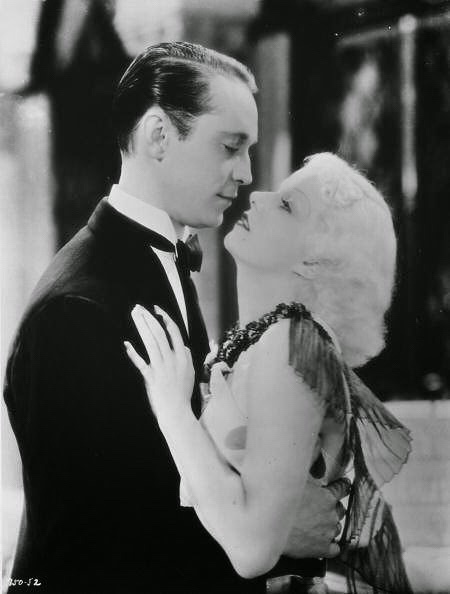There’s nothing like a Pre-Code film to put dated questions of sex and gender into perspective. To continue our examination of Jean Harlow’s FilmStruck series, we take a look at the 1934 romantic dramedy, The Girl From Missouri. Interestingly, the film takes on a brand new identity in this post #MeToo era, and with it a new examination of Jean Harlow’s star persona, this series couldn’t be more timely.
The film follows Eadie Chapman (Harlow) who follows her friend Kitty (Patsy Kelly) into the wilds of New York City. Upon reaching the Big Apple, the ladies throw themselves into the happening Broadway scene. Late nights hoofing in the chorus line of a show, dinners, drinks and questing to land themselves a millionaire… no matter what the age. Lionel Barrymore and Franchot Tone co-star. Jack Conway directs from a script by Anita Loos and John Emerson.

The film is a pre-code dramedy romance, and everything that implies. From the opening frames, Eadie struggles to be a “good girl”. She’s going to get everything she wants in life, and she’s going to keep her virtue to boot. Early in the film Eadie says, “People always think showgirls are wild. But, take me for instance, all the time I’ve been on Broadway, I’m still the same girl as when I left”. Later, Eadie looses her composure as things with Tom (Tone) become particularly heated:
You’re pretty clever aren’t you, shoving me around because I a’int got a Park Avenue accent and a family to stick up for me and make a holla…. I’m not afraid of you, you and your diamond bracelets. A lot of guys think they can buy you for a good meal, but its all the same. I’ve been in spots like this before, and I can take care of myself….Other people have feelings too. I haven’t had an education, alright. I look like a hotsie totsie, alright. No one ever cared whether I amount to anything, but I care!
The moment is a powerful one. Harlow’s delivery is passionate, while Tone doesn’t break eye contact. We’re supposed to be focused on her. The moment builds to a crescendo as Tom pulls Eadie into a passionate embrace… he must have her. The girl has spunk… However, the moment breaks as she dissolves in tears. He looks her over, “That gag of yours about being a good girl… that isn’t on the level, is it?”. Her response is poignant, “I love you so much Tom. You can make me cheap and common like a million others, but I wish you wouldn’t”. Luckily, the camera cuts into a close-up of the pair. Tone in particular is really good in a more simplistic scene. His eyes say a lot without dialogue, and all at once we can see the break in Tom’s character. He suddenly understands her and everything she is feeling.

Once again, we see Franchot Tone playing the rich, fast-living, n’er do well. Of the three most recent performances, this is probably his best in this particular character archetype. He doesn’t play up the bad boy as over-the-top as he does in the other films. As a result, he allows his internet likability to come through a bit more and he doesn’t feel as miscast as he does in something like Reckless.
The complexities in Harlow’s star persona are clearly seen in The Girl from Missouri. Harlow is the blonde bombshell after all. While she’s struggling to move ahead in the world, she’s driving men bonkers. They only see her as a sex object. We see this in the interactions with Tom. As their earlier encounter cools down, he hands her a wad of bills, “Here’s some money. Get some place where I can’t find you. If you don’t, you’ll be sorry and I’ll feel like a heel”. There are many points throughout the film where are adorable leading man gets… more than a little bit rape-ey. There’s encounters that border on abusive and sexual molestation, and thoughts of rape simmer just beneath the surface. However, it’s all justified because she’s a gold-digger… she deserves it… right?
This good girl/bad girl dichotomy is one that keeps popping up in cinema… who are we kidding… it’s something we still struggle with. However, what is interesting in this film is how Eadie is punished. By the WWII era, there was a hard line between good girl and bad girl. Harlow’s character struggles, because while she’s vowing to be a “good” girl, each of the men around her simply assume she’s “bad”. Take Tom’s earlier quote, he can’t believe a girl who looks like Eadie could possibly be good. It must be a gag. So, even as Eadie struggles to do the right thing, it is the perceptions of the people around shaping her place in the narrative. As such, it’s almost frustrating to watch through a contemporary perspective because Eadie goes through such a struggle.
Ultimately, it’s difficult to remember that the actress was dealing with this explosion in (complicated, sexually charged) popularity at a crazily young age. Harlow was reportedly 26 when she passed away in 1937. This would have made her roughly 23 years old at the time of filming. Perhaps most unfortunately, you can see her age on screen. In the age of #MeToo, the treatment of Harlow on-screen is almost less cringeworthy than what could have been (and likely was) happening behind the scenes.
The Girl from Missouri is a fascinating viewing, especially coming from a twenty-first century, post #MeToo era. The film is a solid romantic dramedy, but as the years pass there becomes an increasing amount of problematic material to unpack.FilmStruck’s series on Jean Harlow is perfectly timed. The shifting contemporary landscape necessitates a new take on the legendary actress’ work.

Episode 58: Damesgiving – Citizen Dame
[…] Feminist Friday posts on The Girl From Missouri (1934) and Reckless […]